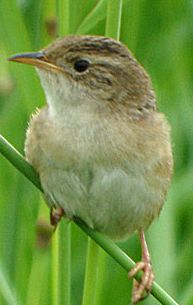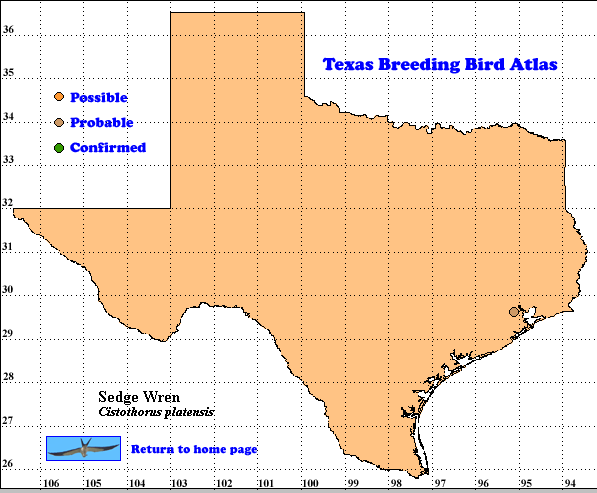Sedge Wren is perhaps the most nomadic of terrestrial bird species in North America, breeding in one part of its range in spring and then apparently moving to a different area to breed again in summer. While breeding may occur at one site for many years, different individuals may be involved each year (Herkert et al.2001).
Sedge Wren, formerly known as Short-billed Marsh Wren, is a complex of 3 groups, possibly separate species. The stellaris group includes a migratory population whose range is described below and 8 other subspecies, resident in a number of separate areas extending from central Mexico to western Panama. In South America, 2 groups, Eastern Grass-Wren (polyglottus group) and Western Grass-Wren (platensis group) include the other 9 subspecies (Herkert et al. 2001).
DISTRIBUTION. During the 1987-1992 field work of the TBBA project, observers found 2 probable breeding records in latilong 29095 (the Houston area).Breeding has not been reported in Texas (Lockwood and Freeman 2004) and the usual breeding range extends from eastern Alberta across southern Canada to Quebec and in the United States from the Dakotas and eastern Nebraska and Kansas across Iowa, Missouri and the Great Lakes states to northern Pennsylvania and New York. Spotty breeding occurs south to the Arkansas and Ohio rivers and east to New Jersey, New England and New Brunswick, Canada. This population migrates to winter along the Atlantic and Gulf coasts from Pennsylvania to Veracruz, Mexico as well as inland in the south Atlantic and Gulf coast states, southern Arkansas, southeast Oklahoma and northeast Mexico (Howell and Webb 1995, Herkert et al. 2001).
Since these two probable breeding records were well inside the winer range of Sedge Wren, they may be late departing or early returning migrants.Since this species is nomadic and breeding might have been attempted in this area.
SEASONAL OCCURRENCE.Lockwood and Freeman (2004) report Sedge Wrens wintering in Texas and Mexico migrate north through this state from late March to late May, returning from late September to early November. Breeding within the usual range described above, occurs from May-September with exact timing varying locally (Herkert et al. 2001).
BREEDING HABITAT. Sedge Wrens nest in wet meadows, hayfields, old fields, and at upland edges of ponds, marshes and sphagnum bogs with tall growth of sedges and grasses. A male builds several nest shells within his territory. These are on the ground or in a small tree or shrub, less than 1 m (3 ft) above ground. Nests are built using sedges and fine grasses interwoven to form a globular ball. A female chooses a nest to line with finer sedges, grasses, feathers and fur. Construction takes 7-8 days. Some males have several mates and some females have a different mate for a second nest.
A female most often lays 7 (range 2-8) smooth, glossy, unmarked, white eggs which she incubates for about 14 (range 13-16) days. Young birds leave the nest 12-14 days after hatching (Herkert et al. 2001).
STATUS. Sedge Wrens are common to uncommon migrants and uncommon to locally common winter residents in eastern Texas (Lockwood and Freeman 2004). Winter abundances in the United States are highest along the Texas and Louisiana coasts (Herkert et al. 2001). Data from 386 Breeding Bird Survey routes of 40 km (25 mi) in length provide a statistically significant population trend of +1.9% change per year for the period 1966-2004 (Sauer et al. 2005). This trend suggests this wren should continue to be a member of the Texas avifauna in years to come..
Text by Robert C. Tweit (2006)
Literature cited.
Herkert, J. R., D. E. Kroodsma and J. P. Gibbs. 2001. Sedge Wren (Cistothorus platensis). In
The birds of North America, No. 582 (A. Poole and F. Gill, eds.). The Birds of North America, Inc., Philadelphia, PA.
Howell, S. N. G. and S. Webb. 1995. A guide to the birds of Mexico and northern Central America. Oxford University Press, New York.
Lockwood, M. W. and B. Freeman. 2004. The TOS handbook of Texas birds. Texas A&M University Press, College Station.
Sauer, J. R., J. E. Hines, and J. Fallon. 2005. The North American Breeding Bird Survey, results and analysis 1966-2004. Version 2005.1. USGS Patuxent Wildlife Research Center, Laurel MD <http://www.mbr-pwrc.usgs.gov/bbs>

